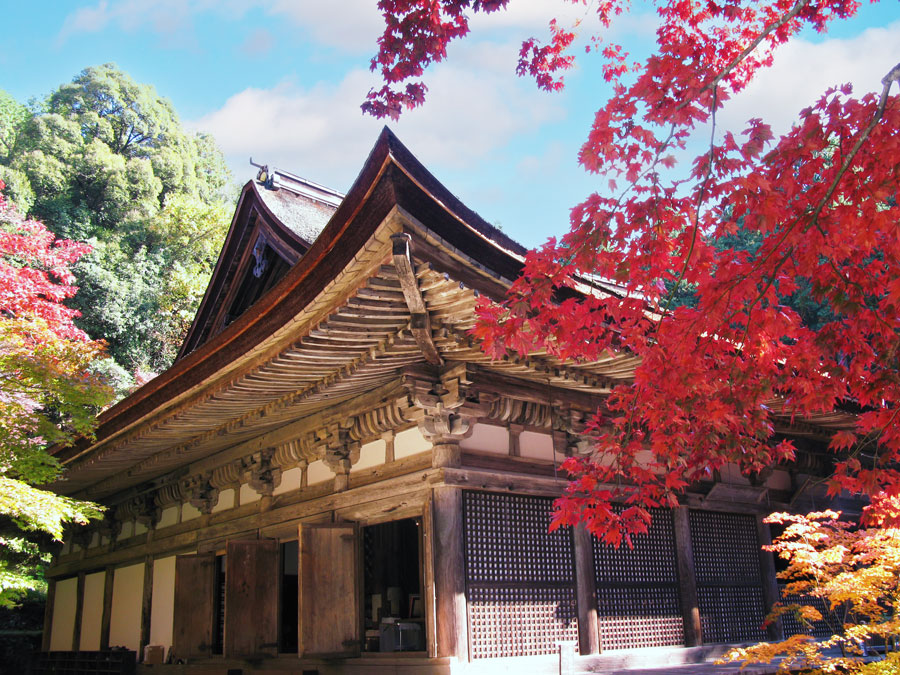歴史
History
金剛輪寺のあらまし
金剛輪寺は、奈良時代の中頃、天平13年(741)に聖武天皇の勅願で行基菩薩によって開山されました。言い伝えによりますと行基菩薩が一刀三礼で観音さまを彫り進められたところ、木肌から一筋の血が流れ落ちたため、その時点で魂が宿ったとして、粗彫りのまま本尊としてお祀りされました。後の世に「生身(なまみ)の観音」と呼ばれるようになり、全国の観音信徒より篤い信仰を集めています。
平安時代の初めには、比叡山より慈覚大師が来山、天台密教の道場とされて以来、延暦寺の末寺、天台宗の大寺院となりました。
鎌倉時代から室町時代にかけて隆盛し、最盛期には百以上の堂宇が建ちならび、数多の僧侶が修行と学問に励んでいました。現存する本堂や仏像などの指定文化財は、全てがこの時代のものです。
戦国時代には織田信長の兵火に見舞われましたが、当時の住職の機知により本堂や三重塔、二天門などの主要な建物は難を逃れました。
江戸時代初期、三代将軍徳川家光公や彦根藩主井伊直孝侯の助力により、衰退していた当山の復興が図られ、境内の整備が進められました。後世、明治維新の廃仏毀釈や第二次世界大戦後の農地解放など、時代の荒波に翻弄されながらも、歴代住職の尽力と全国各地より参拝された方々のお力添えにより、今日の寺観を維持しています。

元寇の役(蒙古襲来)の戦勝記念として、時の近江守護職・佐々木頼綱によって建立された本堂は、鎌倉時代の代表的な和様建造物として国宝に指定されています。堂内には御本尊をはじめ、阿弥陀如来坐像、十一面観音立像など平安から鎌倉時代の仏像が安置され、その多くが国の重要文化財に指定されています。
また、三重塔(鎌倉時代)および二天門(室町時代)も国指定重要文化財で、桃山時代から江戸時代の中期にかけて造られた本坊明壽院の庭園は近江路随一ともいわれ、国の名勝に指定されています。

金剛輪寺本堂内の慈覚大師像
慈覚大師円仁(794~864)
第3世天台座主。下野の人。15歳で最澄に師事し、承和5年(838)中国に渡り、五台山・長安等で勉学、会昌2年武宗の仏教弾圧に遭い、艱難辛苦しながら多くの典籍・教法を持ち帰った。帰朝後は天台密教の大成につとめ、関東東北を巡錫して多くの霊場を開いた。


The history of
KONGOURINJI-temple
KONGOURINJI-temple was established in obedience to an order of the Emperor Shomu in 741.
This temple is sacred to the Kannon Bodhisattva carved by Gyoki Bodhisattva, the first chief priest of the temple. Thereafter, it was attended by many learned priests and grew in both size and status.


In 850, it became a Tendai Buddhism temple after Jikaku Daishi came from the Enryakuji of Mount Hiei.
In 1183. Minamoto Yoshitsune, younger brother of the shogun, dropped in at this temple while he was on an expedition. He prayed for his victory and consecrated his sword.
In 1246, a three-storied pagoda was constructed
In 1274, Japan was invaded for the first time by Mongolian empire. A great number of priests held rites in hope of a victory and peace, and then a heavy typhoon appeared and forced the invaders to withdraw. The main hall "Daihikaku" was constructed as a proof of gratitude to Kannon Bodhisattva in 1288. It is designated as a national treasure representing Japanese architecture in the Kamakura era (1186-1392). The ministry of Education of Japan made a 1/10 scale model of the main hall and put it on exhibition at the National Museum as a representative of Japanese architecture commemorating the Tokyo Olympic Games (1964).
In the Kamakura era, KONGOURlNJI-temple consisted of hundred priest's lodges, and even now, some of the ruins are seen along the approach. Many statues of Buddha were enshrined in them and fourteen of them are designated as important cultural property.


In 1573, the age of turbulence, KONGOURINJI-temple was attacked and burnt. But the wisdom of the priest saved the main hall, the pagoda and Nitenmon (a guardian gate) from the fire.
In Edo era (1603-1867), the first shogun Tokugawa Ieyasu contributed an estate to KONGOURINJI-temple and reconstruction of the ruined edifices started.
In 1632, the Imperial prince erected a branch temple called Seisen-in in KONGOURINJI-temple and practised Buddhistic austerities. In the 18th century, KONGOURINJI-temple had twelve main edifices and two affiliated temples. In 1867, Japan was in disorder due to the rapid change caused by the Meiji Renovation, Buddhism suffered persecution and KONGOURINJI-temple lost its own estate and property and all the priests were forced to leave the temple except for the main edifice Myoju-in.
Since then, reconstructions have been done with the support by a great number of devotees of Buddhism. The main hall was resrored twice, and the three-storied pagoda, which was ruined at the late Edo era, was reconstructed in 1978. KONGOURINJI-temple stands on the east of the lake Biwa, offering a comfortable place and atmosphere to pray for peace and prosperity.

